Abstract
The hydrothermal dynamics of the active layer is a key issue in the study of surface processes in permafrost regions. Even though the soil energy budget is controlled by thermal conduction and latent heat transfer, few studies have focused on their effects upon the active layer thickness (ALT). In the present study, the community land model (CLM) version 5.0 is used to simulate the soil temperature and moisture of the active layers at the Tanggula (TGL) and Beiluhe (BLH) stations in permafrost regions of the Qinghai–Tibet Plateau based on the theory of soil enthalpy in order to estimate the soil energy state and analyze the energy changes in the active layer during freezing and thawing. The results indicate that the soil enthalpy has significant seasonal variation characteristics, which accurately reflected the freezing and thawing processes of the active layer. The change in soil enthalpy is significantly related to the thawing depth of the active layer in TGL and BLH, and its changing process can be expressed as an exponential relationship. Near the surface, the variation of the energy due to temperature gradient and actual evaporation can also be expressed as an exponential relationship. The promoting effect of heat conduction on the ALT is greater than the inhibiting effect of latent heat transfer, with the energy contribution from the phase change accounting for about 20–40% of the energy due to the temperature gradient. The thawing depth increases by 14.16–18.62 cm as the energy due to the temperature gradient increases by 1 MJ/m2 and decreases by 2.75–7.16 cm as the energy due to the phase change increases by 1 MJ/m2. Thus, the present study quantifies the effects of soil energy upon the ALT and facilitates an understanding of the hydrothermal processes in soils in permafrost regions.
1. Introduction
Permafrost is the product of energy and water exchanges between the ground and the atmosphere under certain climatic conditions, and this process is mainly realized through the hydrothermal characteristics of the active layer [1,2]. The active layer is the interface between the permafrost and the atmosphere and represents over 25% of the land and coastal areas on Earth [3]. In permafrost regions, almost all physical, chemical, and biological processes occur on or within the active layer [4].
The permafrost area of the Qinghai–Tibet Plateau (QTP) covers 1.06 × 106 km2, accounting for 40% of the total area of the QTP [5]. However, the permafrost in the QTP is presently degrading due to global warming. In the past 40 years, the active layer thickness (ALT) of the QTP has increased at the rate of 19.5 cm per decade [6], which is expected to have profound impacts upon the surface energy and water balance, hydrogeological processes, ecosystems, carbon exchange between the atmosphere and surface, and human engineering activities [7,8,9,10,11,12,13,14]. Moreover, the hydrothermal changes will lead to further variations in the energy and water exchanges and to large-range alterations in the sensible and latent heat, which may further affect the changes in atmospheric circulation and, hence, the climate system [15]. Therefore, it is very important to fully understand the hydrothermal processes of the active soil layers in permafrost regions.
During the freezing and thawing process, the hydrothermal condition of the active soil layer is closely related to the surface energy budget, and the seasonal thawing depth of the active layer increases with the increase in global radiation [2,16,17,18,19]. Once the active layer has thawed, the rapid increase in soil moisture causes the main energy transfer from latent heat to sensible heat [20]. The soil temperature distribution is an important link in the soil–vegetation–atmosphere energy cycle, and the temperature change in the deep soil layer indicates the capacity of the soil for storing, carrying, and releasing heat energy [21]. During the summer, the soil absorbs heat from the surface and allows it to spread downward; conversely, during the winter, the soil releases the heat upward [22]. Although previous studies have provided a solid foundation for examining the mechanism by which the freeze–thaw process influences the active layer of the QTP, those studies have tended to focus on the importance of the surface energy balance, and have paid little attention to the exchange of energy within the active layer.
The soil enthalpy reflects the changes in the temperature, moisture content, and texture of the soil and can directly reflect the surface heat condition from the energy perspective [23]. Enthalpy has been widely used in the study of regional surface thermal conditions [23,24,25], as well as the improvement of glacier and frozen soil models [26,27,28,29,30,31,32,33,34,35]. The physics of thermal conduction and latent heat transfer have been the basis of several studies on permafrost dynamics and active layer processes, where the heat propagation into and out of the ground is largely controlled by both phase-dependent thermal conductivity and latent heat transfer [34,36]. The Stefan equation governing the thawing process of frozen soil indicates that the thaw depth is controlled by both the thermal conductivity and latent heat of fusion [37,38]. Hence, despite the predominance of thermal conduction in permafrost regions, the influence of nonconductive processes and especially the phase change, upon the freeze–thaw cycle of the active layer, cannot be ignored [39]. Given that the thermal conductivity of ice is four times that of liquid water, and the heat capacity of ice is one-half that of liquid water, frozen soil with a high ice content will transport heat more quickly than soil with an equivalent liquid water content, which means the soil temperature will change greatly [40]. A large amount of energy absorption or release due to the ice-water phase transition (thawing/freezing) keeps the soil temperature close to the freezing point, which can significantly slow down the soil freezing rate and inhibit the temperature change from the surface to the deep soil during the freezing process [32,41]. Enthalpy can represent both the internal energy and phase state of the water, in addition to characterizing any continuous and slight changes in the energy of the ice/water system compared to any discontinuous changes therein during thawing/refreezing [31,32,33]. However, due to the limitation of the natural QTP conditions, it is very difficult to obtain in-situ data. Moreover, while there is a full understanding of soil heat conduction and latent heat transfer, few studies have paid direct attention to their effects upon the ALT.
To accurately simulate the permafrost changes under climate change, the hydrothermal characteristics of the active layer must be clearly understood. Therefore, the energy changes in the active layer during the freezing-thawing process deserve further clarification, and the influence of soil heat conduction and latent heat transfer upon the ALT need further elucidation in order to better understand land-air interaction over the QTP. The aims of the present study are: (i) to explain the energy change and heat transfer of the active soil layer during freezing and thawing based on the concept of soil enthalpy and (ii) to identify the contributions of the energy due to the temperature gradient and the energy due to the phase change towards the overall change in the ALT.
2. Materials and Methods
2.1. Study Sites
The study two monitoring sites used in the present study, namely Tanggula (TGL) and Beiluhe (BLH), are shown in Figure 1.
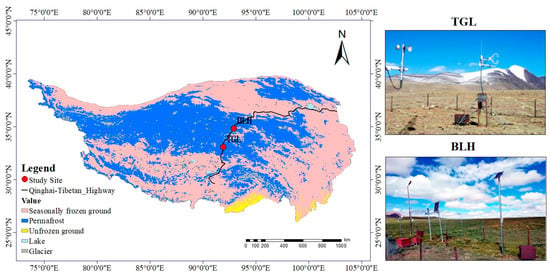
Figure 1.
The location of the studied monitoring sites. The frozen ground map data were derived from [5].
The TGL site is located at 33.04°N, 91.56°E in the southwest region of the Tanggula Mountain pass and is 5100 m above sea level (a.s.l). The main land surface type there is grassy alpine meadow, with a coverage of about 30–40% [42]. The mean annual air temperature at a height of 2 m above the surface is about −4.9 °C [43]. The permafrost thickness is in the range of 80–120 m [44], and the ALT is about 3.36 m [45].
The BLH site is located at 34.82°N, 92.92°E in the upstream regions of the Beiluhe Basin of the central QTP and is 4600 m a.s.l. The main land surface type is the Alpine swamp meadow, with a coverage of about 60–80% [46]. The mean annual air temperature is about −3.4 °C, and the mean annual precipitation is about 369.8 mm y−1 [47]. The permafrost thickness is approximately 20–80 m, with a geothermal gradient of 1.5–4.0 × 10−2 °C/m [48], and the ALT is about 1.6–3.4 m.
2.2. Data Sources
2.2.1. Observation Data
The soil temperature in the active layer was measured using 105 type T thermocouple probes (Campbell Scientific, Inc., Logan, UT, USA) with an accuracy of ± 0.1 °C, and the soil moisture was measured using a Hydro probe (Stevens Water Monitoring System, Inc., Portland, OR, USA) with an accuracy of ± 3%. All instruments were recorded every 0.5 h via a CR1000 data acquisition instrument (Campbell Scientific Inc., USA) [42]. The data used in this study are the daily mean values. The specific time period and the corresponding monitoring depth information are provided in Table 1.

Table 1.
Information on the observed sites.
Due to the lack of observation of soil ice, it is difficult to calculate the soil enthalpy accurately. Hence, to reduce the potential uncertainty and improve the robustness of the results, the soil temperature and soil liquid water were simulated using the community land model (CLM) version 5.0, and the differences between the calculated and observed soil enthalpy parameters during the thawing period were determined in order to eliminate the influence of ice in the soil. The observed atmospheric forcing data with a temporal resolution of 30 min at both the TGL and BLH were used to drive the offline simulation in CLM5.0 (Table 1).
2.2.2. GLEAM
GLEAM is the dataset using a variety of satellite sensor products to estimate daily evaporation at a global scale and 0.25 degree spatial resolution [49,50]. Based on observations of surface net radiation and near-surface air temperature, GLEAM calculated the potential evaporation by the Priestley and Taylor equation. The dataset separately estimated the different components of land evaporation (often referred to as ‘evapotranspiration’): transpiration, bare soil evaporation, interception loss, open water evaporation, and sublimation. The GLEAM_v3.6a dataset is utilized in this study, which is provided on a 0.25° × 0.25° latitude–longitude grid with a daily temporal resolution. The dataset can be freely downloaded (https://www.gleam.eu/, accessed on 1 October 2022).
2.3. Methods
2.3.1. CLM5.0
The CLM is the land component of the community Earth system model (CESM) and is used in several global and regional modeling systems [51]. The Project for the Intercomparison of Land-surface Parametrization Schemes (PILPS) compared more than 20 land surface models under the same initial and boundary value conditions, The results show that the performance of land surface models is obviously different, and the simulation performance of different models on different underlying surfaces has its own advantages and disadvantages [52,53]. Among them, CLM (Community Land Model), as a land surface part of CESM (Community Earth System Model), has become one of the most widely used land surface models [51,54]. As the latest version of CLM, CLM5.0 introduces significant improvements to soil and plant hydrology, including the solution of the Richards equation’s adaptive time step, as well as the refinement of canopy interception and the parameterization scheme of evaporation resistance based on the dry surface of soil [51]. The CLM has been widely used in the study of soil hydrothermal characteristics in the QTP [55,56,57,58] and has been proven to be superior to the Experience, Reflection, Action (ERA) models, the climate forecast system reanalysis (CFSR) model, and the community Noah land surface model in reproducing the freezing–thawing cycle time of shallow soil in the QTP [59].
2.3.2. Soil Enthalpy
The specific enthalpy per unit area (h) is defined by Equation (1):
where u is the specific internal energy, p is the pressure, and v is specific volume (i.e., the inverse of density).
The specific enthalpy (h) of a control volume (Vc) of soil is calculated by using Equation (2):
where , , and are the enthalpies of the soil particles, liquid water, and ice, respectively [60].
By defining a reference temperature, , Equation (2) can be decomposed into Equations (3)–(5):
By using Equations (3)–(5), the energy density, h, in MJ/m3 can be written as:
where is the total heat capacity of the soil, is the freezing temperature (273.15 K), is the latent heat of fusion (3.337 × 105 J/kg), and T is soil temperature (K). These values were obtained from the CLM5.0 offline outputs.
In turn, can be obtained from Equation (7):
where and are the volumetric heat capacities of soil ice (1.942 × 106 J/m3·K) and soil liquid water (4.188 × 106 J/m3·K), respectively, is the density of soil ice (917 kg/m3), and denoteare the volume percentages (m3/m3) of soil ice and soil liquid water, respectively, and and are the volumetric heat capacity and the volume percent of soil practices, respectively. Most of these values were obtained from the CLM5.0 offline outputs, and the values of and were calculated from the 30 × 30 arc-second gridded data on the soil organic matter density and percentage of sand/clay of China [61].
From Equation (6), the soil enthalpy can be divided into the energy () due to the temperature gradient caused by heat conduction under the existing thermal conductivity and the energy () caused by the phase change. These are given by Equations (8) and (9):
The soil enthalpy (h) of the entire active layer (MJ/m2) is then given by Equation (10):
2.3.3. Analytical Methods
The CLM 5.0 was used to divide the soil into 25 layers, where the depths of the first 14 layers were 0–2 cm, 2–6 cm, 6–12 cm, 12–20 cm, 20–32 cm, 32–48 cm, 48–68 cm, 68–92 cm, 92–120 cm, 120–152 cm, 152–188 cm, 188–228 cm, 228–272 cm, and 272–326 cm. The soil temperature and moisture were each calculated at the mid-point of each layer, corresponding to soil depths of 1, 4, 9, 16, 26, 40, 58, 80, 106, 136, 170, 208, 250, and 299 cm. For comparison, the simulated data were then linearly interpolated to obtain the data for the same level that was observed at the site [62,63]. The performance of the simulation was then evaluated by calculating the BIAS, root mean square error (RMSE), and correlation coefficient (Corr) using Equations (11)–(13), respectively:
where N is the number of days of comparison, and are the simulated and average simulated values, respectively, and and are the observed and average observed values, respectively.
3. Results
3.1. Validation of the Model
3.1.1. Soil Temperature
The observed soil temperatures at various soil depths in the active layers at the TGL and BLH locations are compared with the corresponding simulated values in Figure 2, and the detailed statistical data and errors are listed in Table 2. Here, the Corr is seen to decrease as the soil depth increases, with Corr values of >0.95 for depths of 0–100 cm, >0.90 for depths of 100–200 cm, and >0.80 for depths of >200 cm. The soil temperature simulation shows an average cold deviation of 1.29 for the two stations, with average RMSE values of 2.14 and 1.83 for TGL and BLH, respectively. Overall, the simulated soil temperature is in good agreement with the observed value.
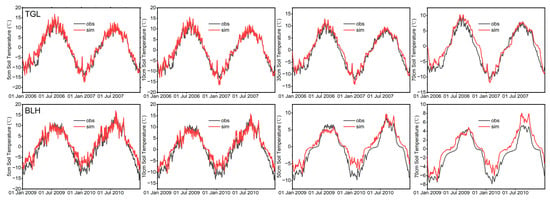
Figure 2.
A comparison of the simulated and observed soil temperatures at various depths at the TGL and BLH sites.

Table 2.
A comparative analysis of the simulated and observed soil temperatures at various depths at the TGL and BLH sites.
3.1.2. Soil Moisture
The observed and simulated soil moisture levels at various soil depths in the active layers at the TGL and BLH sites are compared in Figure 3, and the corresponding statistical data are listed in Table 3. Here, the simulated soil moisture is consistent with the observed values in the shallow layers but is overestimated at greater depths. Further, the BIAS and RMSE are seen to increase with the depth, while the Corr decreases. Thus, in the 0–1 m soil layer, the average Corr is greater than 0.8, the average BIAS is about 0.04, and the average RMSE is 0.06 and 0.1 at TGL and BLH, respectively. However, the simulation accuracy deteriorates significantly at depths of more than 1 m.
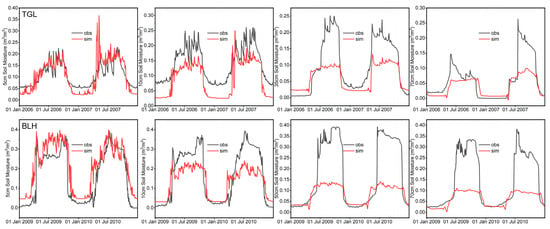
Figure 3.
A comparison of the simulated and observed soil moisture at various depths at the TGL and BLH sites.

Table 3.
A comparative analysis of the simulated and observed soil moisture at various depths at the TGL and BLH sites.
3.1.3. Soil Enthalpy
The observed and simulated soil enthalpies at various soil depths in the active layers at each location are compared in Figure 4, and the corresponding statistical data are summarized in Table 4. Here, only the difference between the measured and simulated values during the thawing period (ice content = 0) are compared, due to the lack of measured data for the soil ice content. Thus, the simulated soil enthalpy shows good consistency with the measured values in the 0–150 cm layer, with BIAS, RMSE, and Corr values of 0.89, 5.79, and 0.68, respectively, at TGL and 1.23, 3.64, and 0.82, respectively, at BLH. However, the accuracy decreases somewhat when the soil depth exceeds about 150 cm. The error between the model simulation and observed soil enthalpy was acceptable, and the results generally reflect the actual situation.
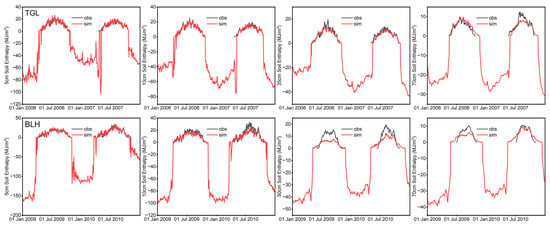
Figure 4.
A comparison of the simulated and observed soil enthalpies at various depths at the TGL and BLH sites.

Table 4.
A comparative analysis of the simulated and observed soil enthalpy at various depths at the TGL and BLH sites.
3.2. Changes of Soil Temperature, Moisture, and Enthalpy at Different Depths
The diurnal variations in soil temperature, moisture, and enthalpy during the period of 1 January 2006 to 31 December 2007 for soil depths of 0–300 cm at the TGL site are presented in Figure 5. Here, the heat distribution and transmission in the active soil layer exhibit distinct characteristics during various stages of the freeze–thaw process. Thus, over the complete freeze–thaw process, each of the active soil layers experience a temperature reduction during the freezing process, and this temperature reduction continues even after complete freezing had occurred, and this is eventually followed by a temperature increase both during and after the process of complete thawing. The freezing period is defined here as the period when the ground temperature is continuously below 0 °C, and the thawing period is defined as the period when the ground temperature is above 0 °C [64]. From 27 April 2006, the surface temperature became positive, and the surface began to thaw from the top down, until the temperature at the bottom of the active layer became 0 °C on 18 August 2006. The vertical change in the temperature of the soil active layer indicates that the freezing process takes place in both directions, with the surface freezing downwards from 13 October 2006, and the bottom of the active layer freezing upwards from 28 October 2006 until 3 November 2006, when the freezing fronts meet at a depth of 140–175 cm, and the active layer became completely frozen until 27 April 2007, when the surface temperature became positive and triggered the next thawing period.
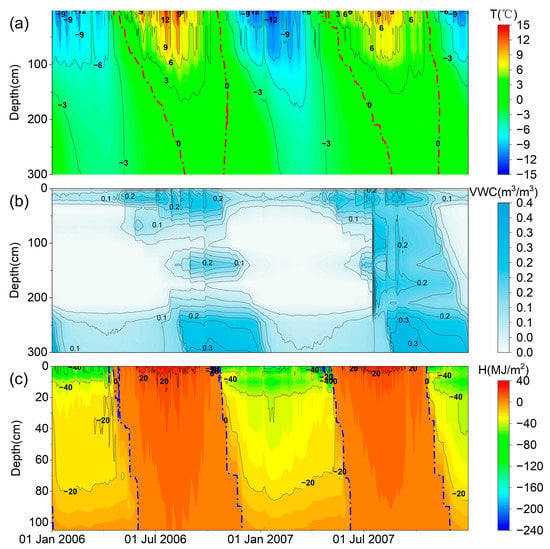
Figure 5.
The variations in (a) the observed soil temperature, (b) the observed soil moisture, and (c) simulated soil enthalpy at various depths during the period of 1 January 2006 to 31 December 2007 at the TGL site.
Notably, the positive and negative changes in the simulated soil enthalpy (Figure 5c) are consistent with the observed freeze–thaw processes of the active layer (Figure 5a,b). Thus, the enthalpy is positive during the thawing period and negative during the freezing period. The soil enthalpy changes most dramatically at the surface, having a maximum value of up to 40 MJ/m3 and reaching a minimum value of about −240 MJ/m3 when the surface temperature drops to a minimum. However, the soil enthalpy decreases sharply with the increase in depth and only varies in the range of −6 to +6 MJ/m3 at depths below 100 cm. Thus, the change in soil enthalpy at the bottom of the active layer is two orders of magnitude smaller than that at the surface.
3.3. Energy Change of Active Layer during Freezing and Thawing
The diurnal variations in H, Qt, and Qw in the active layers at TGL and BLH are shown in Figure 6, and these reflect the seasonal variations in the energy of the active layer. In general, the energy due to the phase change in the active layer exhibits a significant seasonal variation, with a minimum value of close to 0 in the summer and a maximum value of about 20 MJ/m2 in the winter. Meanwhile, the enthalpy and energy due to the temperature gradient each exhibit the opposite trend to that of the energy due to the phase change, with a single maximum value in the summer and a negative value in the winter. In the summer, the soil enthalpy and the energy due to the temperature gradient are similar in value; in winter, however, the soil enthalpy is much lower than the energy due to the temperature gradient, and the difference is equivalent to the energy due to the phase change at that time.
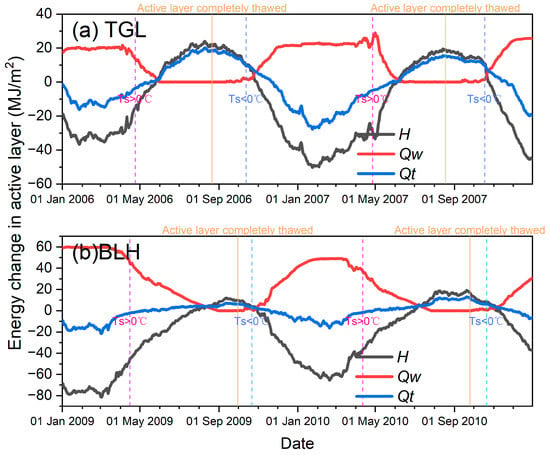
Figure 6.
The diurnal energy changes in the active layer at (a) TGL and (b) BLH.
3.4. The Influence of Soil Enthalpy upon the ALT
The observed variations in H and TD in the active layers at the TGL and BLH sites are presented in Figure 7. Here, it can be seen that the change in H has a significant influence on the TD, and there is a positive correlation between the change in soil enthalpy and the ALT. Thus, the minimum TD value is 0 when H is close to 0.0 MJ/m2, and TD increases with the increase in H. The relation between TD and H can be expressed by Equation (14):
where H is the soil enthalpy of the entire active layer, and a and b are the regression coefficients.
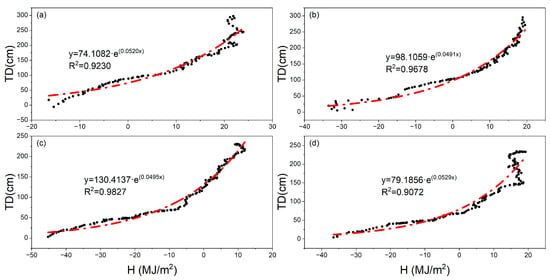
Figure 7.
The effect of soil enthalpy upon the thawing depth (TD) of the active layer (p < 0.05), (a,b) TGL site in 2006 and 2007, (c,d) BLH site in 2009 and 2010.
The values of the regression coefficients can be affected by the local microclimate, the soil texture, the precipitation, and other factors. The coefficient of determination (R2) of TD and H at each site was more than 0.90. The specific regression coefficients of each observation point are presented in Table 5.

Table 5.
The regression coefficients of Equation (14).
4. Discussion
4.1. Variation of Near-Surface Energy and Evapotranspiration during Freezing and Thawing
The freezing–thawing process of the active layer is closely related to the surface energy budget and soil thermal energy variations, and the change in surface energy will eventually lead to a change in the soil heat [22]. The soil enthalpy (H) represents the current energy state of the active layer itself during heat exchange between the ground surface and the atmosphere, with a positive H representing the energy that must be released for complete freezing of the active layer and a negative H representing the energy that must be absorbed for complete thawing of the active layer.
The energy due to the temperature gradient and that due to the phase change in the active layer each exhibit obvious seasonal variations, as shown in Figure 8. These variations are opposite to those in the sensible heat and latent heat in the surface energy balance equation [22,64], thereby reflecting the heat exchange process between the surface and the atmosphere from the perspective of the active soil layer. The energy due to the phase change is the internal energy of soil ice, which only changes significantly during the stage of the diurnal freeze–thaw cycle (April to May and September to October), and this energy remains stable during the period of complete soil freezing and thawing. However, the energy due to the temperature gradient is more intuitively involved in the process of heat exchange between the land surface and the atmosphere.
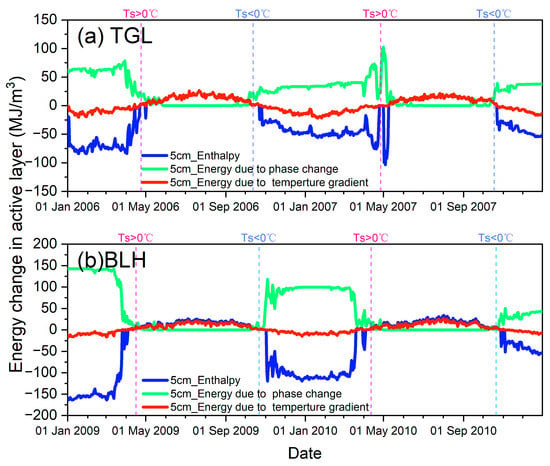
Figure 8.
The energy changes in a 5 cm thickness of soil.
Evapotranspiration (ET) is the process by which liquid water becomes water vapor, and energetically, this accounts for much of the incoming solar radiation [65]. It is a key climate variable connecting the water cycle, energy cycle, and carbon cycle and is closely related to the energy budget of the underlying surface [66,67,68,69]. The increase of sensible heat and decrease of latent heat accounted for the reduced surface evaporation [57].
Figure 9 shows the diurnal variation of actual evaporation (E), which is consistent with the variation trend of energy generated by the temperature gradient. The variations of the energy due to temperature gradient in 5 cm thickness of soil (Qt_5cm) and E in the TGL and BLH sites are shown in Figure 10. The variation between E and Qt_5cm can also be described by an exponential relationship:
where a and b are the regression coefficients.
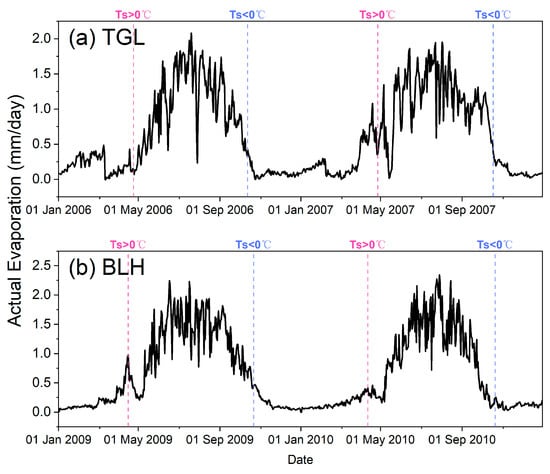
Figure 9.
Seasonal variations in daily diurnal evaporation.
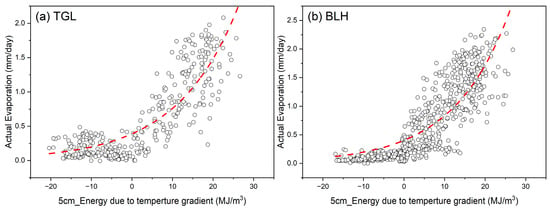
Figure 10.
The energy due to the temperature gradient in 5 cm thickness of soil (Qt_5cm) effects on the diurnal variation of actual evaporation (p < 0.05).
The coefficient of determination (R2) of E and Qt_5cm at each site was more than 0.70. The specific regression coefficients of each observation point are presented in Table 6. This variation can be explained by linking evapotranspiration to soil thermal processes, with less water leaving the surface during the freezing period and evaporation less than 0.5 mm per day. When the surface begins to thaw, the water content in the soil gradually increases and evaporation increases sharply.

Table 6.
The regression coefficients of Equation (15).
During the transition of the active layer from the completely frozen to completely thawed state, the soil is always in a state of heat absorption. As the soil temperature increases, the energy due to the temperature gradient increases. However, because the energy required for the phase change is absorbed by the thawing ice, the temperature of the soil is prevented from rising, and the energy available to the soil due to the phase change is negative. When the soil temperature is close to 0, the positive energy due to the temperature gradient and the negative energy due to the phase change balance each other, and the soil enthalpy is 0. When all of the ice in the active layer has been converted into liquid water, the energy due to the phase change becomes zero and no longer changes; hence, the soil temperature begins to rise continuously, and the soil continuously absorbs heat. At this time, the soil enthalpy is equal to the energy due to the temperature gradient; hence, all of the soil energy is provided by the temperature gradient. After that, the soil enters an exothermic state in which the soil enthalpy and the energy due to the temperature gradient each decrease continuously with the decrease in soil temperature. During this freezing process, however, the energy due to the phase change is released and can offset the decrease in the soil temperature [70]. When the soil temperature decreases to 0 °C, the soil enthalpy becomes 0 again. At this time, most of the liquid water in the soil has frozen into ice, and only a small amount of unfrozen water remains. Until the active layer is completely frozen, the total soil enthalpy retains its minimum value (Figure 6). An important factor affecting the change in permafrost thawing depth is the accumulation of surface energy, which gradually increases with the increase in solar energy [2]. During the thawing period, the heat from the atmosphere is absorbed by the active layer, thereby causing the TD to increase with the increase in soil enthalpy (Figure 7).
4.2. The Contributions of Heat Conduction and Latent Heat Transfer towards the Change in ALT
To clarify the contribution of heat conduction and latent heat transfer towards the ALT, their effects upon the thawing depth are compared in Figure 11. The energy due to the temperature gradient has a significant positive correlation with the TD, while that due to the phase change has a significant negative correlation (R2 > 0.84). Thus, the increase in the energy due to the temperature gradient will promote an increase in the ALT, while that due to the phase change will inhibit the increase in the ALT, which is consistent with the results of previous studies [2,3,32,39,41,71]. The contribution of the energy due to the temperature gradient towards the active layer is stable, which is the primary control over the thickening of the active layer. In addition, the present results show that the thawing depth increases by 14.16–18.62 cm for every 1 MJ/m2 increase in the energy due to the temperature gradient, while the thawing depth decreases by 2.75–7.16 cm for every 1 MJ/m2 increase in the energy due to the phase change. The contribution of the energy due to the phase change towards the change in the ALT accounts for about 20–40% of the energy due to the temperature gradient (Table 7).
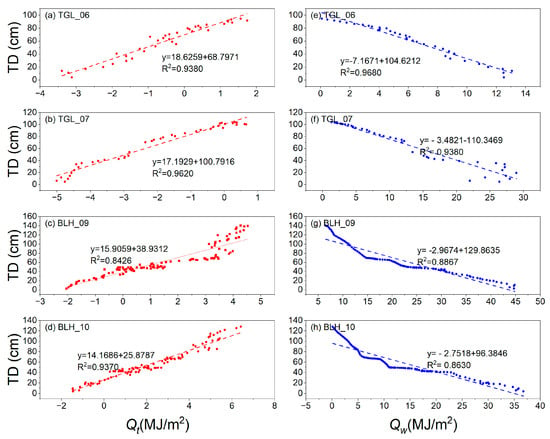
Figure 11.
The effects of the energy due to temperature gradient (Qt) and that due to the phase change (Qw) upon the thawing depth (TD) of the active layer (p < 0.05).

Table 7.
The relative contributions of the energy due to the temperature gradient (Qt) and that due to the phase change (Qw) towards the ALT.
Although the present results quantify the contributions of heat conduction and latent heat towards the ALT, and contribute towards a further understanding of the freezing and thawing processes in the active soil layer, there is a certain deviation in the simulated soil temperature and moisture obtained by using the CLM [56,58]. This is more obvious at the bottom of the active layer and affects the accuracy of the estimated soil energy contribution to the active layer.
However, it should be noted that the soil temperature and moisture are not only affected by the above-mentioned internal factors. The temperature increase in the near-surface permafrost is primarily controlled by regional climatic conditions [71,72]. The surface energy flux and surface soil properties are affected by the seasonal changes in vegetation cover [73]. The rainfall in the spring and summer leads to an increase in the soil water content and changes the surface energy balance, thereby reducing the soil temperature [74,75]. In the winter, the surface snow plays a role in isolating the temperature, with a thicker snow layer leading to a reduction in the heat loss from the soil [76]. These factors each affect the temperature and moisture of the soil to differing degrees, thereby leading to different active layer energies in different areas and ultimately affecting the ALT. Hence, the relationship between the various factors and the energy changes should be explored in future research in order to clarify their influence upon the ALT.
5. Conclusions
In this study, the CLM 5.0 was applied to estimate the soil enthalpy at Tanggula and Beiluhe in the permafrost region of the Qinghai–Tibet Plateau, and the influence of the energy change of the active layer on its thickness during the thawing process was studied; the main conclusions can be drawn as follows:
- (1)
- Soil enthalpy can better reflect the dynamic changes of temperature and moisture during freeze–thaw processes. The soil enthalpy of Tanggula and Beiluhe has obvious seasonal variations, which is smaller in the winter and larger in the summer. The change of soil enthalpy is significantly related to the thawing depth of the active layer, and during the thawing period, TD increases with the increase of H, and its changing process can be expressed as an exponential relationship.
- (2)
- The seasonal variation trend of the energy caused by temperature gradient is the same as that of soil enthalpy, and the variation between actual evaporation and Qt_5cm can also be described by an exponential relationship. The increase of Qt promotes the thickening of the active layer, and the thawing depth increases by 14.16~18.62 cm with the energy increased per 1 MJ/m2.
- (3)
- The seasonal change trend of the energy caused by phase change is opposite to that of soil enthalpy. The increase of Qw inhibits the thickness change of active layer, and the thawing depth decreases by 2.75~7.16 cm with the energy increased per 1 MJ/m2.
- (4)
- The promoting effect of heat conduction on the active layer thickness is greater than the inhibiting effect of latent heat transfer on the active layer thickness, and the contribution of the energy caused by the phase change to the thickness of the active layer accounts for about 20~40% of the energy caused by the temperature gradient.
Author Contributions
Conceptualization, R.L., L.Z. and S.W.; methodology, S.W.; software, S.W., J.M. and S.Y.; validation, Y.J., Y.X. and W.L.; formal analysis, R.L., J.Y. and S.W.; investigation, L.Z., T.W., X.W., Y.Q. and Y.X. data curation, J.S.; writing—original draft preparation, S.W. and R.L.; writing—review and editing, R.L., T.W., X.W. and G.H.; visualization, S.W., J.M. and Y.J.; and funding acquisition, R.L. and T.W. All authors have read and agreed to the published version of the manuscript.
Funding
This work was supported by the National Natural Science Foundation of China (42071093); the National Key Research and Development Program of China (2020YFA0608502); the State Key Laboratory of Cryospheric Science (SKLCS-ZZ-2022); the National Natural Science Foundation of China (42071094); and the Natural Science Foundation of Gansu Province (22JR5RA061, 22JR5RA054, and 21JR7RA063).
Data Availability Statement
The measured data at the Tanggula and Beiluhe stations are derived from Cryosphere Research Station on the Qinghai-Tibet Plateau, Chinese Academy of Sciences (http://new.crs.ac.cn/, accessed on 7 September 2022). The CLM5.0 model is available from Community Earth System Model (https://www.cesm.ucar.edu/, accessed on 7 September 2022).
Acknowledgments
The support from the Cryosphere Research Station on the Qinghai–Tibetan Plateau was especially appreciated.
Conflicts of Interest
The authors declare no conflict of interest.
References
- Anisimov, O.A.; Shiklomanov, N.I.; Nelson, F.E. Global Warming and Active-Layer Thickness: Results from Transient General Circulation Models. Glob. Planet. Chang. 1997, 15, 61–77. [Google Scholar] [CrossRef]
- Li, R.; Zhao, L.; Wu, T.; Ding, Y.; Xiao, Y.; Hu, G.; Zou, D.; Li, W.; Yu, W.; Jiao, Y.; et al. The Impact of Surface Energy Exchange on the Thawing Process of Active Layer over the Northern Qinghai–Xizang Plateau, China. Environ. Earth Sci. 2014, 72, 2091–2099. [Google Scholar] [CrossRef]
- Dobiński, W. Permafrost Active Layer. Earth-Sci. Rev. 2020, 208, 103301. [Google Scholar] [CrossRef]
- Ling, F.; Zhang, T. A Numerical Model for Surface Energy Balance and Thermal Regime of the Active Layer and Permafrost Containing Unfrozen Water. Cold Reg. Sci. Technol. 2004, 38, 1–15. [Google Scholar] [CrossRef]
- Zou, D.; Zhao, L.; Sheng, Y.; Chen, J.; Hu, G.; Wu, T.; Wu, J.; Xie, C.; Wu, X.; Pang, Q.; et al. A New Map of Permafrost Distribution on the Tibetan Plateau. Cryosphere 2017, 11, 2527–2542. [Google Scholar] [CrossRef]
- Zhao, L.; Zou, D.; Hu, G.; Du, E.; Pang, Q.; Xiao, Y.; Li, R.; Sheng, Y.; Wu, X.; Sun, Z.; et al. Changing Climate and the Permafrost Environment on the Qinghai–Tibet (Xizang) Plateau. Permafr. Periglac. Process. 2020, 31, 396–405. [Google Scholar] [CrossRef]
- Cheng, G.; Wu, T. Responses of Permafrost to Climate Change and Their Environmental Significance, Qinghai-Tibet Plateau. J. Geophys. Res. 2007, 112, F02S03. [Google Scholar] [CrossRef]
- Wu, T.; Zhao, L.; Li, R.; Wang, Q.; Xie, C.; Pang, Q. Recent Ground Surface Warming and Its Effects on Permafrost on the Central Qinghai-Tibet Plateau. Int. J. Climatol. 2013, 33, 920–930. [Google Scholar] [CrossRef]
- Song, Y.; Jin, L.; Wang, H. Vegetation Changes along the Qinghai-Tibet Plateau Engineering Corridor Since 2000 Induced by Climate Change and Human Activities. Remote Sens. 2018, 10, 95. [Google Scholar] [CrossRef]
- Cheng, G.; Zhao, L.; Li, R.; Wu, X.; Sheng, Y.; Hu, G.; Zou, D.; Jin, H.; Li, X.; Wu, Q. Characteristic, changes and impacts of permafrost on Qinghai-Tibet Plateau. Chin. Sci. Bull. 2019, 64, 2783–2795. [Google Scholar] [CrossRef]
- Chai, M.; Li, G.; Ma, W.; Cao, Y.; Wu, G.; Mu, Y.; Chen, D.; Zhang, J.; Zhou, Z.; Zhou, Y.; et al. Assessment of Freeze–Thaw Hazards and Water Features along the China–Russia Crude Oil Pipeline in Permafrost Regions. Remote Sens. 2020, 12, 3576. [Google Scholar] [CrossRef]
- Xu, X.; Wu, Q. Active Layer Thickness Variation on the Qinghai-Tibetan Plateau: Historical and Projected Trends. JGR Atmos. 2021, 126, e2021JD034841. [Google Scholar] [CrossRef]
- Wang, J.; Wang, C.; Zhang, H.; Tang, Y.; Duan, W.; Dong, L. Freeze-Thaw Deformation Cycles and Temporal-Spatial Distribution of Permafrost along the Qinghai-Tibet Railway Using Multitrack InSAR Processing. Remote Sens. 2021, 13, 4744. [Google Scholar] [CrossRef]
- Li, H.; Liu, F.; Zhang, S.; Zhang, C.; Zhang, C.; Ma, W.; Luo, J. Drying–Wetting Changes of Surface Soil Moisture and the Influencing Factors in Permafrost Regions of the Qinghai-Tibet Plateau, China. Remote Sens. 2022, 14, 2915. [Google Scholar] [CrossRef]
- Ma, Z.; Wei, H.; Fu, Z. Progress In The Research On The Relationship Between Soil Moisture And Climate Change. Adv. Earth Sci. 1999, 14, 300–303. [Google Scholar]
- Kou, Y.; Zeng, Q.; Xie, W.; Xiao, S. Investigation Of Radiation On Qinghai-Xizang Plateau and Its Neighbouring Districts and the Relation Between Radiation And Permafrost on It. J. Glaciol. Geocryol. 1981, 39, 25–32. [Google Scholar]
- Yao, J.; Zhao, L.; Gu, L.; Qiao, Y.; Jiao, K. The Surface Energy Budget in the Permafrost Region of the Tibetan Plateau. Atmos. Res. 2011, 14, 394–407. [Google Scholar] [CrossRef]
- Gu, L.; Yao, J.; Hu, Z.; Zhao, L. Comparison of the Surface Energy Budget between Regions of Seasonally Frozen Ground and Permafrost on the Tibetan Plateau. Atmos. Res. 2015, 153, 553–564. [Google Scholar] [CrossRef]
- Yang, K.; Wang, C. Seasonal Persistence of Soil Moisture Anomalies Related to Freeze–Thaw over the Tibetan Plateau and Prediction Signal of Summer Precipitation in Eastern China. Clim. Dyn. 2019, 53, 2411–2424. [Google Scholar] [CrossRef]
- You, Q.; Xue, X.; Peng, F.; Dong, S.; Gao, Y. Surface Water and Heat Exchange Comparison between Alpine Meadow and Bare Land in a Permafrost Region of the Tibetan Plateau. Agric. For. Meteorol. 2017, 232, 48–65. [Google Scholar] [CrossRef]
- Sun, S. Physical and Biochemical Mechanisms and Parameterized Models of Land Surface Processes; China Meterological Press: Beijing, China, 2005; ISBN 978-7-5029-4024-9. [Google Scholar]
- Ma, J.; Li, R.; Liu, H.; Huang, Z.; Wu, T.; Hu, G.; Xiao, Y.; Zhao, L.; Du, Y.; Yang, S. The Surface Energy Budget and Its Impact on the Freeze-Thaw Processes of Active Layer in Permafrost Regions of the Qinghai-Tibetan Plateau. Adv. Atmos. Sci. 2022, 39, 189–200. [Google Scholar] [CrossRef]
- Zhao, C.; Chen, H.; Sun, S. Evaluating the Capabilities of Soil Enthalpy, Soil Moisture and Soil Temperature in Predicting Seasonal Precipitation. Adv. Atmos. Sci. 2018, 35, 445–456. [Google Scholar] [CrossRef]
- Chen, J.; Kumar, P. A Modeling Study of the ENSO Influence on the Terrestrial Energy Profile in North America. J. Clim. 2004, 17, 1657–1670. [Google Scholar] [CrossRef]
- Zhao, C.; Chen, H.; Sun, S. Long-Term Trend of Land Surface Thermal States and Its Spatial Variability in the Eastern Region of the Northern Hemisphere. Front. Earth Sci. 2020, 8, 126. [Google Scholar] [CrossRef]
- Zhang, Z.; Zhou, X.; Li, W.; Sparrow, M. Calculation of the Energy Budget for Heterogeneous Land Surfaces. Earth Interact. 2003, 7, 1–12. [Google Scholar] [CrossRef]
- Li, Q.; Sun, S.; Dai, Q. The Numerical Scheme Development of a Simplified Frozen Soil Model. Adv. Atmos. Sci. 2009, 26, 940–950. [Google Scholar] [CrossRef]
- Li, Q.; Sun, S.; Xue, Y. Analyses and Development of a Hierarchy of Frozen Soil Models for Cold Region Study. J. Geophys. Res. 2010, 115, D03107. [Google Scholar] [CrossRef]
- Calvo, N.; Durany, J.; Vázquez, C. Enthalpy Balance Methods versus Temperature Models in Ice Sheets. Commun. Nonlinear Sci. Numer. Simul. 2015, 22, 526–544. [Google Scholar] [CrossRef]
- Kleiner, T.; Rückamp, M.; Bondzio, J.H.; Humbert, A. Enthalpy Benchmark Experiments for Numerical Ice Sheet Models. Cryosphere 2015, 9, 217–228. [Google Scholar] [CrossRef]
- Bao, H.; Koike, T.; Yang, K.; Wang, L.; Shrestha, M.; Lawford, P. Development of an Enthalpy-Based Frozen Soil Model and Its Validation in a Cold Region in China: An Enthalpy-Based Frozen Soil Model. J. Geophys. Res. Atmos. 2016, 121, 5259–5280. [Google Scholar] [CrossRef]
- Ding, B.; Yang, K.; Yang, W.; He, X.; Chen, Y.; Lazhu; Guo, X.; Wang, L.; Wu, H.; Yao, T. Development of a Water and Enthalpy Budget-Based Glacier Mass Balance Model (WEB-GM) and Its Preliminary Validation: ENERGY-BASED GLACIER MASS BALANCE MODEL. Water Resour. Res. 2017, 53, 3146–3178. [Google Scholar] [CrossRef]
- Wang, L.; Zhou, J.; Qi, J.; Sun, L.; Yang, K.; Tian, L.; Lin, Y.; Liu, W.; Shrestha, M.; Xue, Y.; et al. Development of a Land Surface Model with Coupled Snow and Frozen Soil Physics. Water Resour. Res. 2017, 53, 5085–5103. [Google Scholar] [CrossRef]
- Amiri, E.A.; Craig, J.R.; Hirmand, M.R. A Trust Region Approach for Numerical Modeling of Non-Isothermal Phase Change. Comput. Geosci. 2019, 23, 911–923. [Google Scholar] [CrossRef]
- Tubini, N.; Gruber, S.; Rigon, R. A Method for Solving Heat Transfer with Phase Change in Ice or Soil That Allows for Large Time Steps While Guaranteeing Energy Conservation. Cryosphere 2021, 15, 2541–2568. [Google Scholar] [CrossRef]
- Schuh, C.; Frampton, A.; Christiansen, H.H. Soil Moisture Redistribution and Its Effect on Inter-Annual Active Layer Temperature and Thickness Variations in a Dry Loess Terrace in Adventdalen, Svalbard. Cryosphere 2017, 11, 635–651. [Google Scholar] [CrossRef]
- Walvoord, M.A.; Kurylyk, B.L. Hydrologic Impacts of Thawing Permafrost—A Review. Vadose Zone J. 2016, 15, vzj2016.01.0010. [Google Scholar] [CrossRef]
- French, H.M. The Periglacial Environment, 4th ed.; J. Wiley: Hoboken, NJ, USA, 2018; ISBN 978-1-119-13282-0. [Google Scholar]
- Kane, D.L.; Hinkel, K.M.; Goering, D.J.; Hinzman, L.D.; Outcalt, S.I. Non-Conductive Heat Transfer Associated with Frozen Soils. Glob. Planet. Chang. 2001, 29, 275–292. [Google Scholar] [CrossRef]
- Zhang, X.; Sun, S. The Impact of Soil Freezing/Thawing Processes on Water and Energy Balances. Adv. Atmos. Sci. 2011, 28, 169–177. [Google Scholar] [CrossRef]
- Luo, L.; Robock, A.; Vinnikov, K.Y.; Schlosser, C.A.; Slater, A.G.; Boone, A.; Etchevers, P.; Habets, F.; Noilhan, J.; Braden, H.; et al. Effects of Frozen Soil on Soil Temperature, Spring Infiltration, and Runoff: Results from the PILPS 2(d) Experiment at Valdai, Russia. J. Hydrometeorol. 2003, 4, 334–351. [Google Scholar] [CrossRef]
- Li, R.; Zhao, L.; Wu, T.; Wang, Q.; Ding, Y.; Yao, J.; Wu, X.; Hu, G.; Xiao, Y.; Du, Y.; et al. Soil Thermal Conductivity and Its Influencing Factors at the Tanggula Permafrost Region on the Qinghai–Tibet Plateau. Agric. For. Meteorol. 2019, 264, 235–246. [Google Scholar] [CrossRef]
- Xiao, Y.; Zhao, L.; Dai, Y.; Li, R.; Pang, Q.; Yao, J. Representing Permafrost Properties in CoLM for the Qinghai–Xizang (Tibetan) Plateau. Cold Reg. Sci. Technol. 2013, 87, 68–77. [Google Scholar] [CrossRef]
- Wang, J.; Wang, S.; Qiu, G. Permafrost Along The Qinghai-Xizang Highway. Acta Geogr. Sin. 1979, 34, 18–32. [Google Scholar]
- Li, R.; Zhao, L.; Ding, Y.; Wu, T.; Xiao, Y.; Du, E.; Liu, G.; Qiao, Y. Temporal and Spatial Variations of the Active Layer along the Qinghai-Tibet Highway in a Permafrost Region. Chin. Sci. Bull. 2012, 57, 4609–4616. [Google Scholar] [CrossRef]
- Qin, Y.; Wu, T.; Wu, X.; Li, R.; Xie, C.; Qiao, Y.; Hu, G.; Zhu, X.; Wang, W.; Shang, W. Assessment of Reanalysis Soil Moisture Products in the Permafrost Regions of the Central of the Qinghai–Tibet Plateau. Hydrol. Process. 2017, 31, 4647–4659. [Google Scholar] [CrossRef]
- Yin, G.; Niu, F.; Lin, Z.; Luo, J.; Liu, M. Effects of Local Factors and Climate on Permafrost Conditions and Distribution in Beiluhe Basin, Qinghai-Tibet Plateau, China. Sci. Total Environ. 2017, 581–582, 472–485. [Google Scholar] [CrossRef] [PubMed]
- Lin, Z.; Niu, F.; Xu, Z.; Xu, J.; Wang, P. Thermal Regime of a Thermokarst Lake and Its Influence on Permafrost, Beiluhe Basin, Qinghai-Tibet Plateau. Permafr. Periglac. Process. 2010, 21, 315–324. [Google Scholar] [CrossRef]
- Miralles, D.G.; Holmes, T.R.H.; De Jeu, R.A.M.; Gash, J.H.; Meesters, A.G.C.A.; Dolman, A.J. Global Land-Surface Evaporation Estimated from Satellite-Based Observations. Hydrol. Earth Syst. Sci. 2011, 15, 453–469. [Google Scholar] [CrossRef]
- Martens, B.; Miralles, D.G.; Lievens, H.; van der Schalie, R.; de Jeu, R.A.M.; Fernández-Prieto, D.; Beck, H.E.; Dorigo, W.A.; Verhoest, N.E.C. GLEAM v3: Satellite-Based Land Evaporation and Root-Zone Soil Moisture. Geosci. Model. Dev. 2017, 10, 1903–1925. [Google Scholar] [CrossRef]
- Lawrence, D.M.; Fisher, R.A.; Koven, C.D.; Oleson, K.W.; Swenson, S.C.; Bonan, G.; Collier, N.; Ghimire, B.; van Kampenhout, L.; Kennedy, D.; et al. The Community Land Model Version 5: Description of New Features, Benchmarking, and Impact of Forcing Uncertainty. J. Adv. Model. Earth Syst. 2019, 11, 4245–4287. [Google Scholar] [CrossRef]
- Henderson-Sellers, A.; Yang, Z.-L.; Dickinson, R.E. The Project for Intercomparison of Land-Surface Parameterization Schemes. Bull. Am. Meteorol. Soc. 1993, 74, 1335–1350. [Google Scholar] [CrossRef]
- Pitman, A.J.; Henderson-Sellers, A.; Desborough, C.E.; Yang, Z.-L.; Abramopoulos, F.; Boone, A.; Dickinson, R.E.; Gedney, N.; Koster, R.; Kowalczyk, E.; et al. Key Results and Implications from Phase 1(c) of the Project for Intercomparison of Land-Surface Parametrization Schemes. Clim. Dyn. 1999, 15, 673–684. [Google Scholar] [CrossRef]
- Decker, M.; Zeng, X. Impact of Modified Richards Equation on Global Soil Moisture Simulation in the Community Land Model (CLM3.5): Impact of modified richards equation. J. Adv. Model. Earth Syst. 2009, 1, 5. [Google Scholar] [CrossRef]
- Yang, K.; Wang, C.; Li, S. Improved Simulation of Frozen-Thawing Process in Land Surface Model (CLM4.5). J. Geophys. Res. Atmos. 2018, 123. [Google Scholar] [CrossRef]
- Yang, S.; Li, R.; Wu, T.; Wu, X.; Zhao, L.; Hu, G.; Zhu, X.; Du, Y.; Xiao, Y.; Zhang, Y.; et al. Evaluation of Soil Thermal Conductivity Schemes Incorporated into CLM5.0 in Permafrost Regions on the Tibetan Plateau. Geoderma 2021, 401, 115330. [Google Scholar] [CrossRef]
- Yang, K.; Wang, C. Water Storage Effect of Soil Freeze-Thaw Process and Its Impacts on Soil Hydro-Thermal Regime Variations. Agric. For. Meteorol. 2019, 265, 280–294. [Google Scholar] [CrossRef]
- Deng, M.; Meng, X.; Lyv, Y.; Zhao, L.; Li, Z.; Hu, Z.; Jing, H. Comparison of Soil Water and Heat Transfer Modeling Over the Tibetan Plateau Using Two Community Land Surface Model (CLM) Versions. J. Adv. Model. Earth Syst. 2020, 12, e2020MS002189. [Google Scholar] [CrossRef]
- Li, N.; Cuo, L.; Zhang, Y. On the Freeze–Thaw Cycles of Shallow Soil and Connections with Environmental Factors over the Tibetan Plateau. Clim. Dyn. 2021, 57, 3183–3206. [Google Scholar] [CrossRef]
- Dall’Amico, M.; Endrizzi, S.; Gruber, S.; Rigon, R. A Robust and Energy-Conserving Model of Freezing Variably-Saturated Soil. Cryosphere 2011, 5, 469–484. [Google Scholar] [CrossRef]
- Shangguan, W.; Dai, Y.; Liu, B.; Zhu, A.; Duan, Q.; Wu, L.; Ji, D.; Ye, A.; Yuan, H.; Zhang, Q.; et al. A China Data Set of Soil Properties for Land Surface Modeling. J. Adv. Model. Earth Syst. 2013, 5, 212–224. [Google Scholar] [CrossRef]
- Zhu, Z.; Shi, C.; Zhang, T.; Wang, J. Applicability analysis of four soil moisture reanalysis datasets in China. Plateau Meteorol. 2018, 37, 240–252. [Google Scholar]
- Yang, K.; Zhang, J. Evaluation of Reanalysis Datasets against Observational Soil Temperature Data over China. Clim. Dyn. 2018, 50, 317–337. [Google Scholar] [CrossRef]
- Guo, D.; Yang, M.; Wang, H. Characteristics of Land Surface Heat and Water Exchange under Different Soil Freeze/Thaw Conditions over the Central Tibetan Plateau. Hydrol. Process. 2011, 25, 2531–2541. [Google Scholar] [CrossRef]
- Zhang, Y.; Peña-Arancibia, J.L.; McVicar, T.R.; Chiew, F.H.S.; Vaze, J.; Liu, C.; Lu, X.; Zheng, H.; Wang, Y.; Liu, Y.Y.; et al. Multi-Decadal Trends in Global Terrestrial Evapotranspiration and Its Components. Sci. Rep. 2016, 6, 1–12. [Google Scholar] [CrossRef] [PubMed]
- Yang, W.; Wang, Y.; Liu, X.; Zhao, H.; Wang, G.; Shao, R. Estimating the Evaporation in the Fenghuo Mountains Permafrost Region of the Tibetan Plateau. CATENA 2020, 194, 104754. [Google Scholar] [CrossRef]
- Fisher, J.B.; Melton, F.; Middleton, E.; Hain, C.; Anderson, M.; Allen, R.; McCabe, M.F.; Hook, S.; Baldocchi, D.; Townsend, P.A.; et al. The Future of Evapotranspiration: Global Requirements for Ecosystem Functioning, Carbon and Climate Feedbacks, Agricultural Management, and Water Resources. Water Resour. Res. 2017, 53, 2618–2626. [Google Scholar] [CrossRef]
- Wang, K.; Dickinson, R.E. A Review of Global Terrestrial Evapotranspiration: Observation, Modeling, Climatology, and Climatic Variability: Global Terrestrial Evapotranspiration. Rev. Geophys. 2012, 50, RG2005. [Google Scholar] [CrossRef]
- Jung, M.; Reichstein, M.; Ciais, P.; Seneviratne, S.I.; Sheffield, J.; Goulden, M.L.; Bonan, G.; Cescatti, A.; Chen, J.; de Jeu, R.; et al. Recent Decline in the Global Land Evapotranspiration Trend Due to Limited Moisture Supply. Nature 2010, 467, 951–954. [Google Scholar] [CrossRef]
- Li, Q.; Xue, Y.; Liu, Y. Impact of Frozen Soil Processes on Soil Thermal Characteristics at Seasonal to Decadal Scales over the Tibetan Plateau and North China. Hydrol. Earth Syst. Sci. 2021, 25, 2089–2107. [Google Scholar] [CrossRef]
- Clayton, L.K.; Schaefer, K.; Battaglia, M.J.; Bourgeau-Chavez, L.; Chen, J.; Chen, R.H.; Chen, A.; Bakian-Dogaheh, K.; Grelik, S.; Jafarov, E.; et al. Active Layer Thickness as a Function of Soil Water Content. Environ. Res. Lett. 2021, 16, 055028. [Google Scholar] [CrossRef]
- Wu, X.; Shi, W.; Fang, H.; Li, W.; Zhao, Y.; Zhao, L. Distribution of soils and landform relationships in the permafrost regions of Qinghai-Xizang (Tibetan) Plateau. Chin. Sci. Bull. 2015, 60, 2216–2226. [Google Scholar] [CrossRef]
- Wang, G.; Liu, G.; Li, C.; Yang, Y. The Variability of Soil Thermal and Hydrological Dynamics with Vegetation Cover in a Permafrost Region. Agric. For. Meteorol. 2012, 162–163, 44–57. [Google Scholar] [CrossRef]
- Wen, Z.; Niu, F.; Yu, Q.; Wang, D.; Feng, W.; Zheng, J. The Role of Rainfall in the Thermal-Moisture Dynamics of the Active Layer at Beiluhe of Qinghai-Tibetan Plateau. Env. Earth Sci. 2014, 71, 1195–1204. [Google Scholar] [CrossRef]
- Douglas, T.A.; Turetsky, M.R.; Koven, C.D. Increased Rainfall Stimulates Permafrost Thaw across a Variety of Interior Alaskan Boreal Ecosystems. NPJ Clim. Atmos. Sci. 2020, 3, 28. [Google Scholar] [CrossRef]
- Zhou, X.; Buchli, T.; Kinzelbach, W.; Stauffer, F.; Springman, S.M. Analysis of Thermal Behaviour in the Active Layer of Degrading Mountain Permafrost: Thermal Behaviour in the Active Layer of Degrading Mountain Permafrost. Permafr. Periglac. Process. 2015, 26, 39–56. [Google Scholar] [CrossRef]
Disclaimer/Publisher’s Note: The statements, opinions and data contained in all publications are solely those of the individual author(s) and contributor(s) and not of MDPI and/or the editor(s). MDPI and/or the editor(s) disclaim responsibility for any injury to people or property resulting from any ideas, methods, instructions or products referred to in the content. |
© 2022 by the authors. Licensee MDPI, Basel, Switzerland. This article is an open access article distributed under the terms and conditions of the Creative Commons Attribution (CC BY) license (https://creativecommons.org/licenses/by/4.0/).